A typical Bremisch January day is over, and depressing rain is hammering against my living room window. I’m lying on the couch staring at my camera collection, thinking about my new year’s resolution. I promised myself I would fight my GAS problem. I bet that many of you have the same problem: “Gear Acquisition Syndrome,” or in short, you simply have too many cameras to use them all.
Almost ten cheap point-and-shoot cameras are gathering dust on my shelf. After endless conversations about minimalism and Marie Kondō marathons during the Christmas season, I feel encouraged enough to let go of most cameras in my collection. I set myself the goal of only keeping one camera of each film format I like to shoot (35 and 645). So I ask myself with every camera, “Does it spark joy?” and flog it on. In the end, I only keep one 35mm compact, a Canon Snappy S, which is a terrible camera, but I’ve shot some fond memories with it, so I can’t let it go.
After a lot of training and haggling at Ebay, I’m left with a fair bit of money in my bank account and no decent 35mm left. So I started researching which camera to get. After just selling a lot of simple point and shoots, I’m on the hunt for something more upmarket, something solid, something that gives me more creative control and also something that has beautiful glass up front and is still compact enough to carry around all the time. My research narrowed down to three cameras: the Nikon 35Ti, Minolta TC1, and Contax T.
After trying all three cameras at a local shop, I decided to spend my money on the Nikon 35Ti. Both the Minolta and the Contax are fantastic cameras but the viewfinders couldn’t win me over. The finder on the TC is absolutely tiny and blacks out very fast. The T has a nice and bright finder but it’s small range finder patch (at least with this particular one) was simply too clunky to use for my personal liking.
For the last 9 Months the little titanium brick served me as my primary shooter, capturing spontaneous events such as pizza parties in the “Schrebergarten” or grand days out at the beach. About 10 rolls later, summer is coming to a close and thick rain is taking over again. I’m sitting on my couch, looking through the photos I’ve taken with the Ti, reflecting if camera is potent and the shooting experience “sparks joy” enough to justify keeping it. Image wise I can already say I do really like the results of the 35Ti. Exposure and autofocus are bang on, the lens is sharp and color rendering is absolutely beautiful. But the “joy” part of question is not that easy to answer. Here are my thoughts and experiences I made during the better part of a year using it.
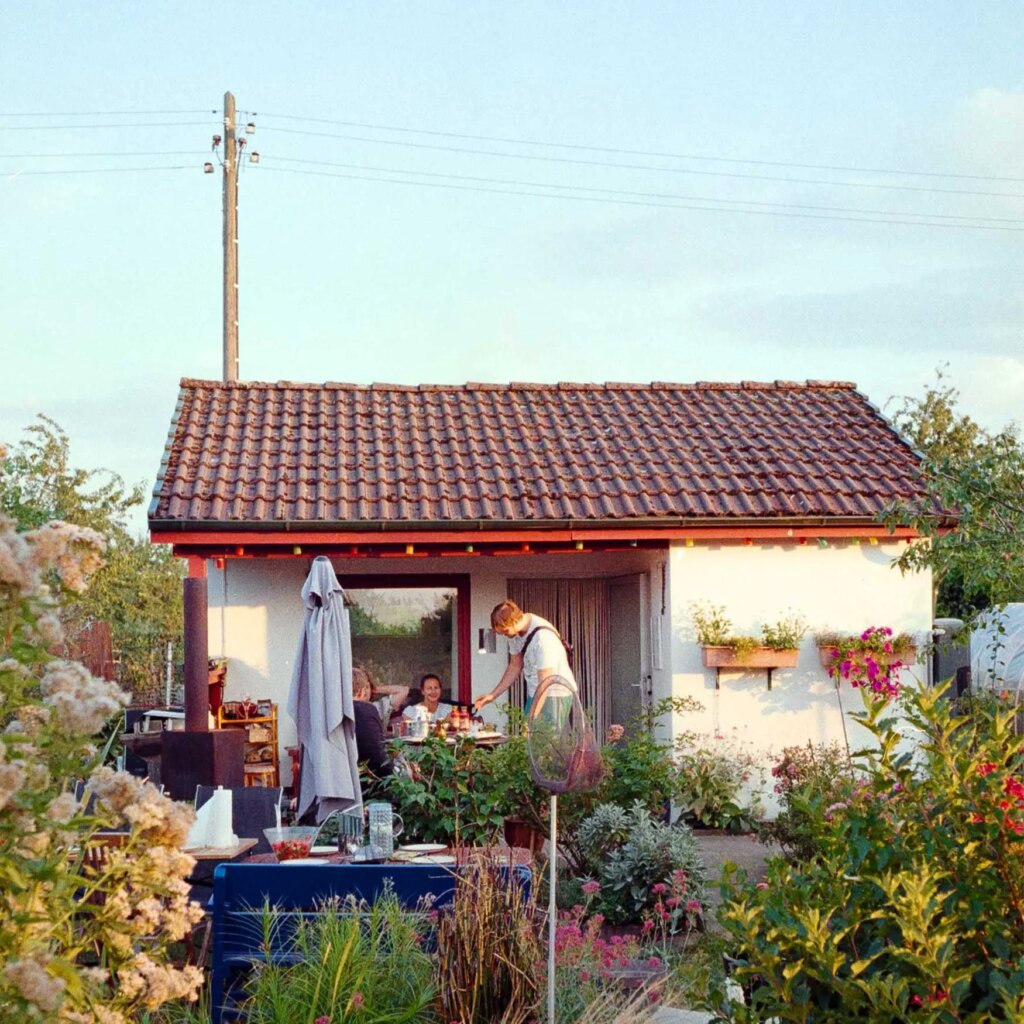
The Body
Build quality
I owned a fair number of compacts over the last decade, from Olympuses to Leica rebranded compacts to metal-made cameras like the Rollei 35 SE or the PEN S. None of them can reach the quality of the Ti. Everything is made from metal; there is no plastic to interact with. Really impressive.
Design ascetics
I think the Nikon 35 Ti and 28 Ti perfectly capture Japanese product design aesthetics, with it’s idiosyncratic, slightly historicizing analogue dials up top and uncompromised lines. I think it is one of the most beautiful compacts ever made. Even nearly 30 years later, it still looks every bit as good as it did in 1994. But the designers clearly have chosen style over usability. More on that later.
Pockatabilty
You won’t be able to chuff this one in the pocket of your Levi’s unless you wear a pair of 90s cargo pants. But to be honest, most compacts aren’t portable. Other manufactures know that. That’s why most compacts I owned had the option for a neck strap to keep the thing in front of your chest while out and about. The Ti, and this applies to both models, only has one lug for a wrist strap. which is unfortunate. With nearly 370g hanging from your wrist your hand gets numb in no time.
Durability
Yes, it is an electronic camera from the mid 90s and yes like all things in life, it will eventually break. But the engineering is much more solid, then like say compared to a Ricoh R1 or GR1 with failing displays or TVS’s with breaking flex cables. Buying something that old always comes with a risk.
The Inner Workings
Lens and Meter
The scans don’t really show it but the lens is sharp like a razor knife, much sharper than the lens on my old Mju II. Color rendering is beautiful too. Rumor hazard the lens is a direct copy of Contaxes T2 lens. I can’t confirm that, but it is certainly playing in the same league. Together with the fantastic Nikon matrix meter the 35Ti works real wonders. The meter even manages to correctly expose pictures taken in straight sunlight. Hands down, it must be one of the best meters ever built into a compact. At least from my experience.


Noise
Not much of a biggie for me. I’m not so much into street photography, so a stealthy camera is not that important. The autofocus is quite loud. Film rewind is relatively quiet. It is one of the quieter cameras that I own.
Handling
Modes
Besides the fabulous design, lens, and meter, the main reasons for me getting this camera are the setting options. The Ti has three modes: “Program,” “Aperture Priority,” and “Timed”. Set to “Program” the camera determines, like any other compact, the correct exposure values when half pressing the shutter button. But unlike most compacts values can be shifted. Just keep the button half press and rotate the thumbwheel in the desired direction. The value shift is followed up on the analog dials up top and the digital display in the finder. This is a great option to get more captive control over your images. Aperture mode works like a treat as well. Together with the pre-set focusing distance, zone focusing becomes possible, which makes the camera quite a bit more snappy. The “T” or “Timed” mode is nice to have but, at least for me, not really needed.
Ergonomics
The camera is shaped like a brick and is about as ergonomic as one. The lens isn’t located at the center of the camera; it is off-set to the right, which leaves little space to place your fingers. There is nothing to rest your thumb against, so when holding the camera you are more clinging onto it than comfortable holding it. This gets tiering easily.
Interface
At first sight, the interface of the camera is beautiful. Some say the dials up top are useless. I can’t agree with that. I’m used to working with cameras that don’t display all the info (speed, aperture, exposure compensation) in one place. In fact, my Fuji GS645 has the same issue. In the finder, you only get the information from the meter. For everything else to check, you have to lift the camera from your eye. One could argue that Nikon could have displayed every bit of information in the finder because they had the technology available from their SLR line-up. I did a bit of research on that. Most cameras from the era like the TC1, the T2, or the GR have the same issue. From my knowledge, the Leica CM, which is a much later camera, is the only compact to displays both shutter speed and aperture in the finder. Even this camera can’t show both values at the same time. Leica solves the issue by constantly alternating between values.
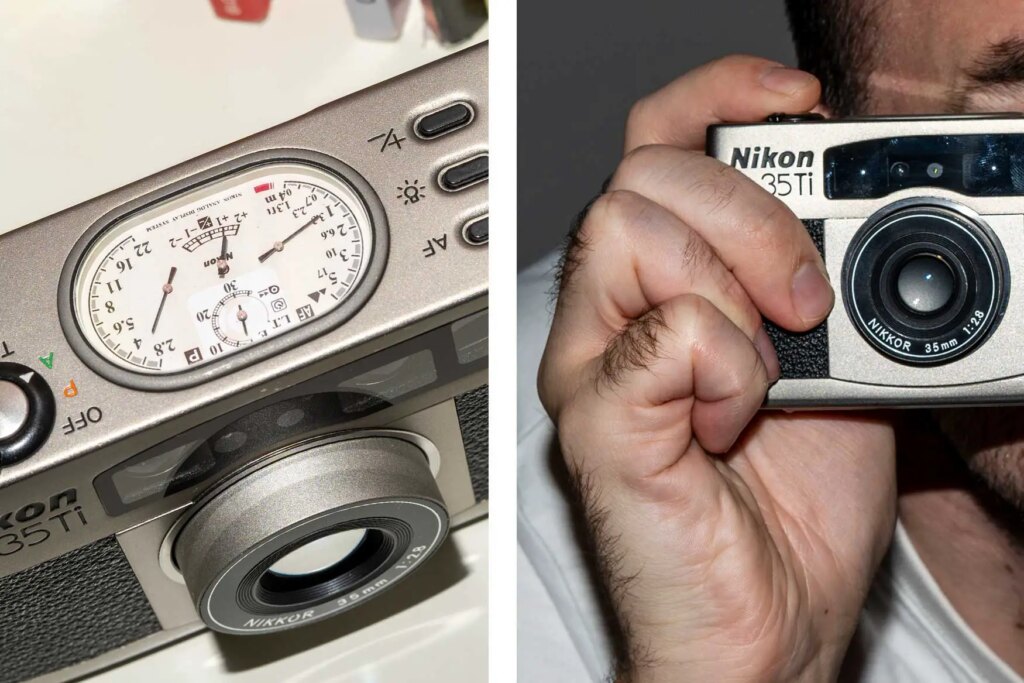
Setting the aperture via the multi-function wheel works very well. This can be done with one on hand, unlike the T2 or the TC1 which needs two like any other SLR. Setting something else, like the manual focus or exposure compensation, is a bit more fiddly because you have to press the desired button up top next to the displays and then turn the wheel. But I had compacts with worse interfaces. Like the R1, which requires cycling through the modes to get to infinity mode, for example. After turning the Ti off, it memorizes some settings, which is neat if, for example, you would like to over expose an entire roll of film, which I sometimes like to do.
Flash settings
Like a cheap Canon point and shoot, the camera decides if it wants to use the flash or not. If you want to suppress the flash, you have to press a tiny button on the front of the camera. For some reason, Nikon decided that you have to press it with two tons of pressure to make it work. That might be a problem with my particular camera, but still.
Tactile feed back is one thing an other is the oder in which the buttons have to be operated get to the desired result, flash or no flash. Once you half press shutter button and the exposure is looked, you can press the flash overwrite buttons as much as you like they won’t do a thing.
So to make things work correctly you either predict that the camera wants to use the flash in advance, press the button up front, then press the shutter button, or you half press the shutter, and if the flash symbol is lighting up, release the button, press the no flash button, and operate the shutter again. The same procedure goes if you like the flash to fire. But! Other than your average Canon, the Ti doesn’t just fire the flash in forced flash mode, it enters slow shutter flash sync or whatever it is called mode. What that means is, the camera releases the shutter at a slower speed to draw in some light from the background and then fries the flash at the end of the exposure to freeze the subject in the foreground. This works extremely well when the camera is stationary and the background isn’t moving. But shooting from the hand, the photos become quite artsy and probably not what you want them to look like. As far as I know, this can be changed via the general settings menu.
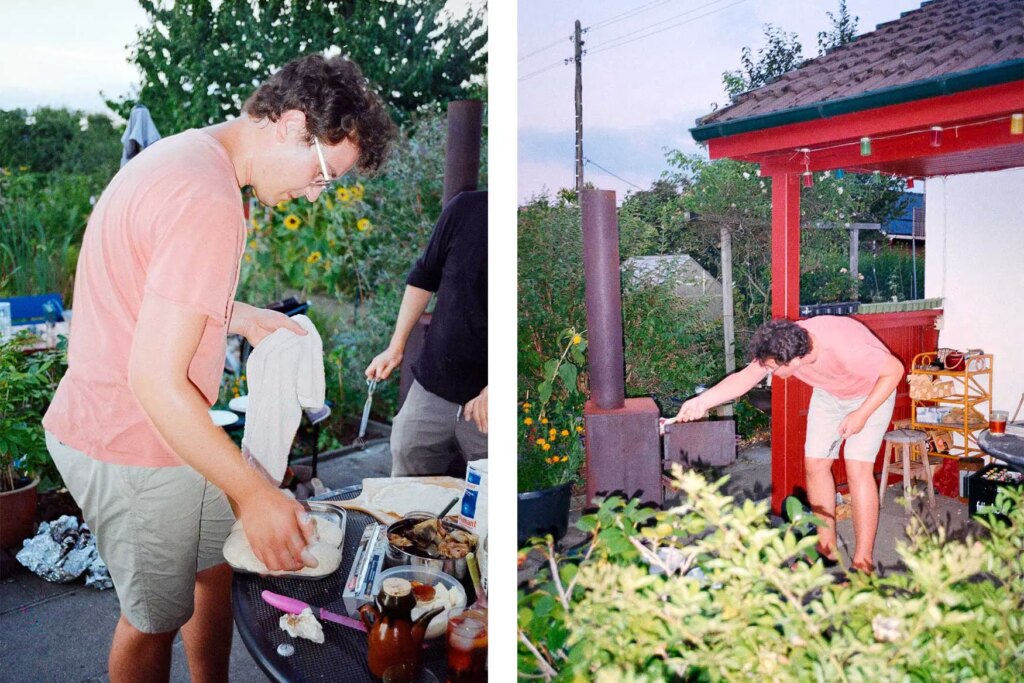
In doing so, you also turn off the back lighting feature of the viewfinder lines, which usually light up when a sensor up front registers enough natural light to display them via the strange window up top. Which is more than annoying because then the finder becomes not much more than a window to look through. Sadly, Nikon didn’t mark the buttons to make them distinguishable. I found myself several times hitting the wrong one. Or getting it right but not pushing it hard enough. The 28Ti solved this with a little switch, which works way, way better.
Other than that, the flash is fantastic. Most of the time, the meter chooses excellent settings. With a guide number of 9 (ISO 100, in meters), it is well equipped for all kinds of situations.
General settings menu
Luckily, you don’t need to use it that often, but programming the camera is really annoying. For example, you can decide if the camera should display the shutter speed or the aperture settings in the finder. To switch between them, you have to use a binary code sequence, which is dialed in via the two date setting buttons at the back of the camera. You definitely need a toothpick and lots of patience. This is nothing you can achieve quickly on the go. It took me the better part of 10 minutes to finally get everything set up. The sad thing is you have to repeat the process every time you remove the battery. The same goes for the date settings. I’m not sure if the Ti had a buffer battery in the past; if so, mine is dead for sure.
Viewfinder
The viewfinder is nice and bright. It displays the aperture or speed (can be changed via the infamous menu), if the flash or composure compensation modes are active, and frame lines for normal or panoramic mode (can be deactivated). Top Tip: It is worth removing the black eyepiece around the finder. Without the eyepiece in place, the field of view increases by quite a bit. For some reason I don’t quite get, removing the piece changes the viewfinder to -1 diopter. With the eyepiece attached the finder has a value of +0.5.
Pros and Cons
Street
Pros
+ Build quality
+ No sleep mood if you turn it on it stays on
+ Fast lesne
+ Accurate Meter
+ Zone focusing capabilities
Cons
– Brick like ergonomics
– Flash settings
– Interface if you have to be fast
– Relatively loud
– Relatively slow focus if you want to take images of moving subjects
– Heavy
Travel
Pros
+ Build quality
+ Fast Lens
+ Meter
+ Accurate focus
+ Programm shift
Cons
– Flash settings
– Interface if you have to be fast
– Heavy
– Only one lug for wrist strap
Landscape
Pros
+ Bild quality
+ Fast lens
+ Meter
+ Manual scale-focus
+ Programm shift
+ Aperture priority
+ T mode with second indication
Cons
– Flash settings
– Only one lug for wrist strap
– Shutter speed only up to 1/500 of a second
– No filter thread
Conclusion
So does the 35Ti spark enough joy to keep it? There are things about that camera that I absolutely adore, the looks, the lens and meter. And there are other things that I find utterly annoying. Like those stupid flash settings or the menu. But all things considered I think the Ti is a keeper even thought I use it in P mode like 95% of the time.
Now the question is, should you buy one? After all, this is probably the reason why you are reading this. Well, it depends on what you want. I don’t think you should buy one if you are looking for a quick street shooter, but if you want a beautiful camera that can take stunning portraits and landscape shots, this is the one for you. Even thought the lens is not as good, I suggest getting the 28Ti because this one solves the flash setting issues with a more convenient switch up front.
There is another review of the 35Ti here and here.
Follow me if you like
– – –
Instagram: bureauklein
Web: lennartklein.com
Share this post:
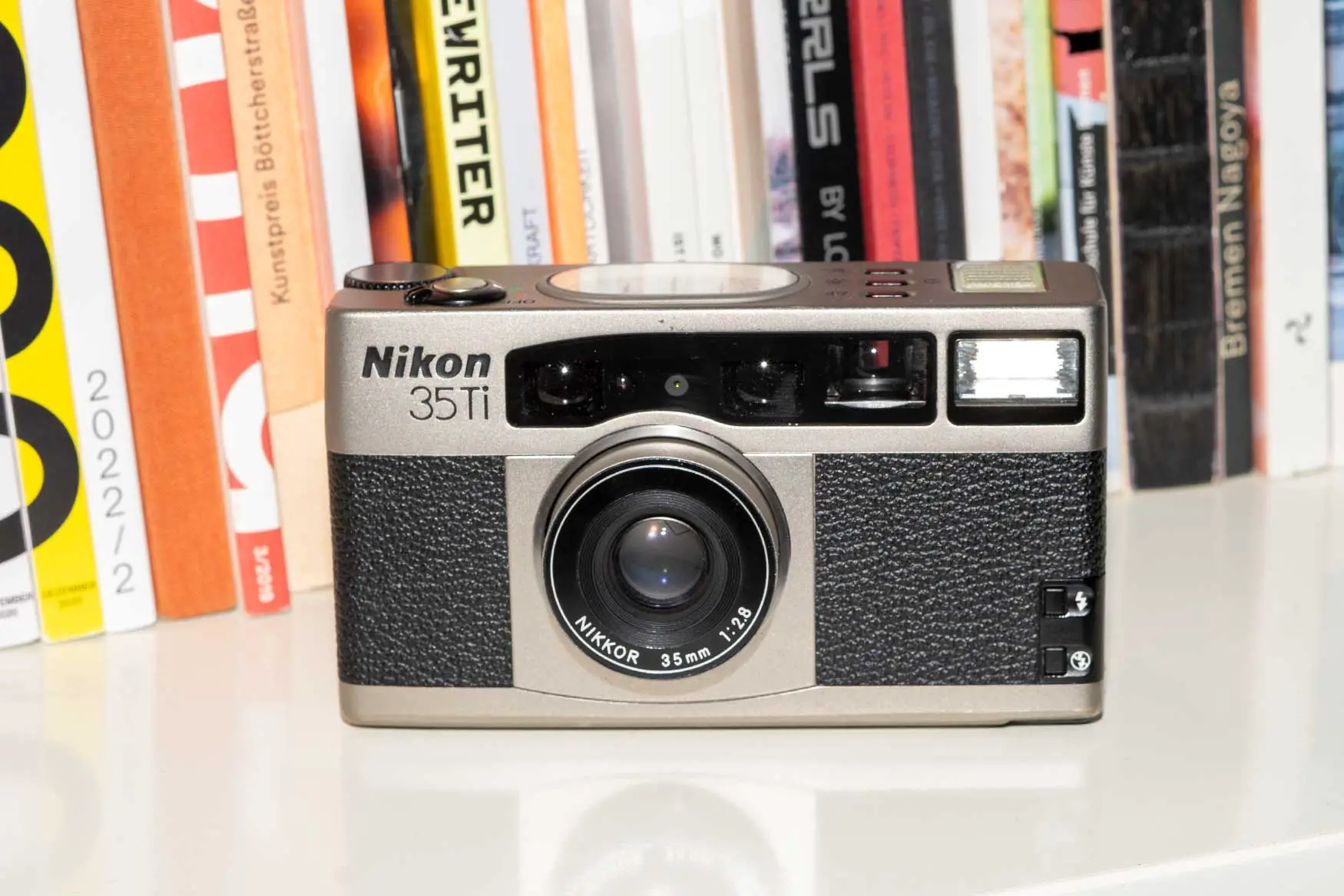


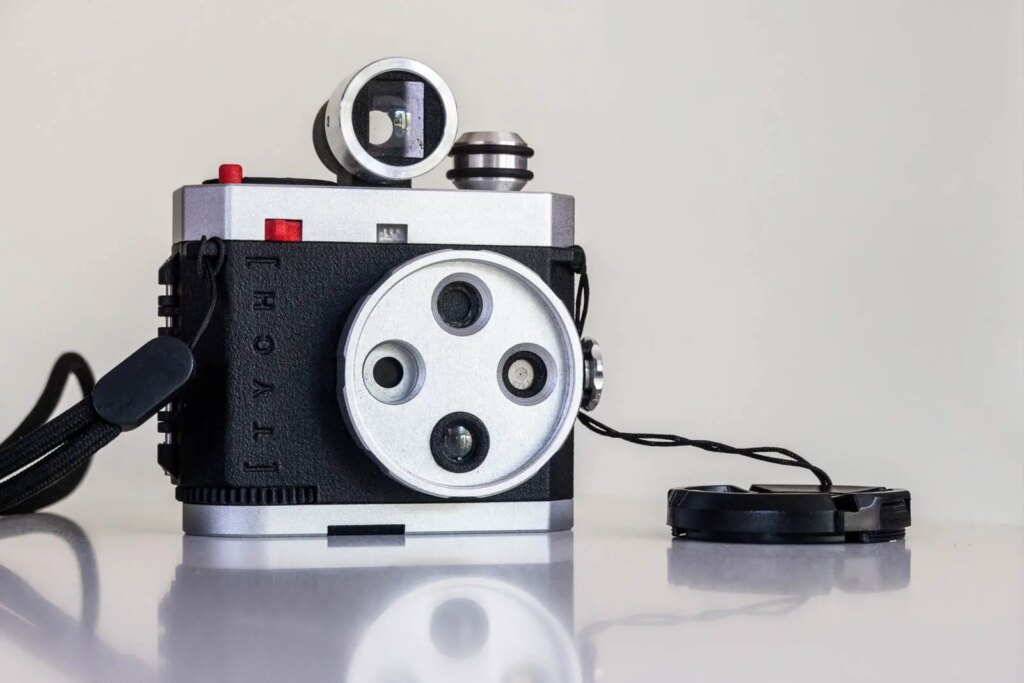
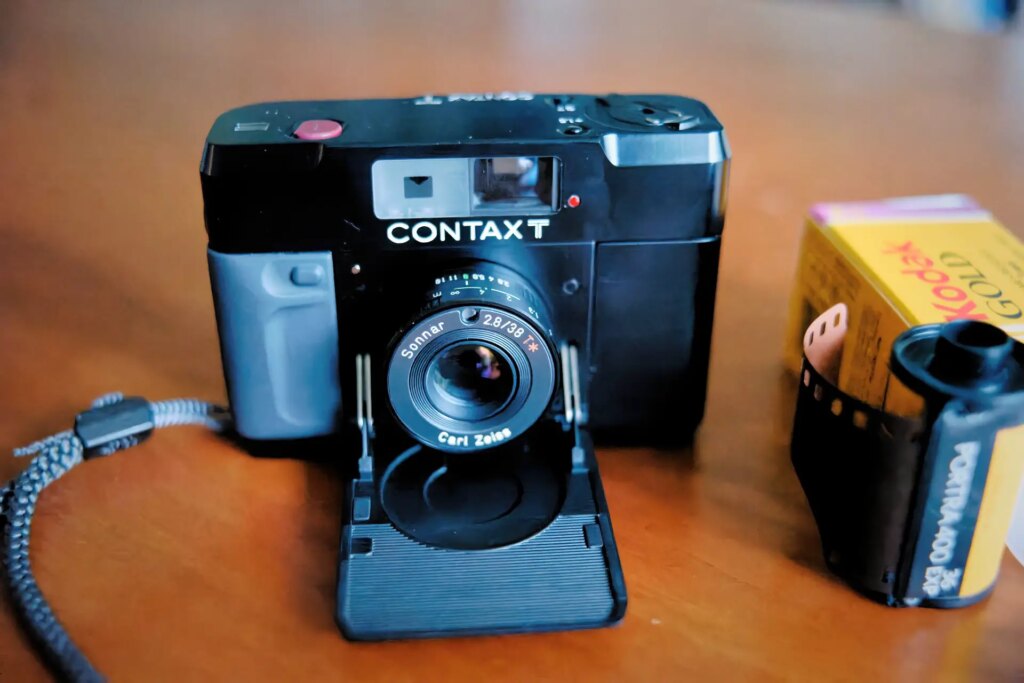




Comments
Andrew L on Nikon 35 Ti – Long Term Impressions – By Lennart Klein
Comment posted: 06/12/2022
Hermann on Nikon 35 Ti – Long Term Impressions – By Lennart Klein
Comment posted: 06/12/2022
The Nikon is truly marvelous, AF and Meter way better than the Contax T2. The only thing that annoyed me was how loud the lens is moving while turning the camera on.
Comment posted: 06/12/2022
Paul Trantow on Nikon 35 Ti – Long Term Impressions – By Lennart Klein
Comment posted: 06/12/2022
Comment posted: 06/12/2022
Des McSweeney on Nikon 35 Ti – Long Term Impressions – By Lennart Klein
Comment posted: 06/12/2022
Rodney A. Johnson on Nikon 35 Ti – Long Term Impressions – By Lennart Klein
Comment posted: 07/12/2022
Alexander Seidler on Nikon 35 Ti – Long Term Impressions – By Lennart Klein
Comment posted: 07/12/2022
Huss on Nikon 35 Ti – Long Term Impressions – By Lennart Klein
Comment posted: 07/12/2022
Comment posted: 07/12/2022
Elcasse on Nikon 35 Ti – Long Term Impressions – By Lennart Klein
Comment posted: 20/02/2023
Thanks for your review
Comment posted: 20/02/2023